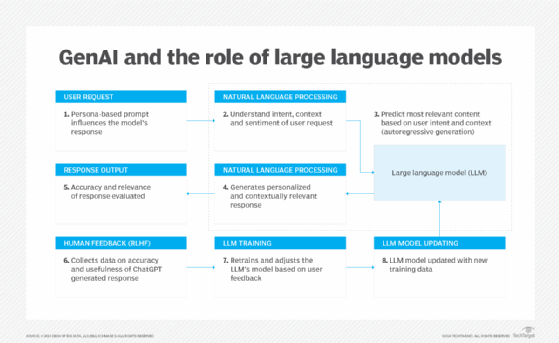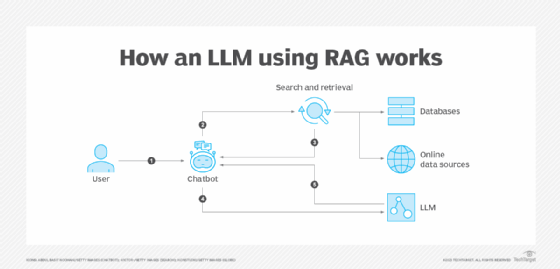
Getty Images/iStockphoto
Use RAG with LLMs to democratize data analytics
Pairing retrieval-augmented generation with an LLM helps improve prompts and outputs, democratizing data access and making previously elusive information available to more users.
Organizations can use retrieval-augmented generation with large language models to democratize data analytics, lowering the technical skill barrier employees need to use data in daily tasks.
LLMs provide advanced capabilities to translate data queries into answers that any user can understand. RAG ensures the most accurate results possible.
The rising popularity of LLMs is due to their sophisticated ability to parse, categorize and engage with intricate user queries in ways that mimic human interaction. LLMs can provide answers to questions, condense articles and craft descriptive captions.
Despite their remarkable capabilities, LLMs have limitations. They occasionally yield responses that may be inaccurate, obsolete or off-topic. Inaccuracies primarily occur due to their reliance on preexisting data sets that may not include the most current or detailed information that users seek.
RAG can help mitigate these challenges in LLM-generated responses.
How LLMs work
LLMs are sophisticated algorithms created by processing vast amounts of textual data from diverse sources, including books, websites and articles. They use advanced machine learning techniques to codify the complexities, subtleties and patterns of human language. These capabilities help LLMs discern and replicate the relationships between concepts within data sets. Through extensive training, LLMs can generate human-like responses in style and content.
When a user inputs a prompt into an LLM, the model draws from its training to generate text that is relevant and contextually nuanced. The process involves analyzing the prompt, determining the most appropriate response based on learned patterns, and constructing a coherent and context-specific reply.

LLMs can improve users' engagement with digital information. They are pivotal in democratizing data access and dismantling traditional barriers to knowledge and expertise. LLMs can unlock new avenues of insight and learning for individuals by distilling intricate data into accessible language.
How RAG improves LLM performance
RAG intercepts a request before it gets to a public LLM and augments the user's request with proprietary organizational data. It forwards the modified prompt to the LLM to get a more accurate and relevant response.
RAG is a cost-effective and scalable way to improve LLMs' quality and usefulness without retraining models on new data. RAG works for any domain or task that requires external knowledge, such as medical diagnosis, legal advice or product reviews. Users can customize RAG to use different knowledge sources, such as data or proprietary information, to suit specific needs and preferences.
For example, suppose you ask an LLM to write a summary of the latest news about COVID-19. The LLM might not have the most recent or reliable data on the pandemic and may generate an outdated or inaccurate summary. But RAG -- with a knowledge source that contains the latest news articles and statistics about COVID-19 -- can retrieve the most relevant information from the knowledge source and augment your request with that information. The LLM can then generate a summary based on the augmented request, reflecting the current situation and facts about COVID-19.
The RAG prompt intercept process streamlines obtaining highly relevant answers through a straightforward four-step methodology:
- User submits request. The user poses a question or seeks specific information. This initial step establishes the inquiry's foundation and the user's intentions.
- Request intercepted and augmented. The RAG intercepts and adds to the original request. The enhancement refines the request, ensuring it's primed to elicit the most pertinent and comprehensive answer possible from the LLM.
- Augmented query submitted to LLM. The RAG forwards the request to the LLM with extra details. The infusion of context ensures the LLM's response is accurate and meticulously tailored to address the nuances and specificities of the request.
- Tailored response returned. The answer, enriched by the preceding steps, is a more accurate and relevant response that aligns with the initial query. This personalized approach guarantees an accurate answer and uniquely suits individual needs.

The future of LLMs and RAG
The combination of LLMs and RAG to perform tasks that traditionally require human intelligence has use cases in many industries, including education, customer service and creative fields. Using RAG with LLMs to democratize data analytics and access can foster more informed decision-making, enhance creativity and improve efficiency in problem-solving across various domains. As technology evolves, the RAG-LLM combination can help make data more accessible, personal, relevant and actionable in several ways:
- Enhanced personalization and relevance. Future RAG systems could become more adept at tailoring responses to individuals by using historical data, personal preferences and context.
- Blending knowledge across domains. RAG technology has applications across various sectors, including healthcare, education, finance and customer service. Integrating proprietary organizational data with the vast knowledge base of LLMs can provide deep and wide-ranging insights and answers. For example, RAG could enable more personalized patient care by combining medical literature with individual patient records in healthcare.
- Real-time information updating. As organizations continually update their databases, RAG systems can quickly incorporate the latest information.
- Bridging the knowledge gap. RAG has the potential to democratize knowledge by making specialized, hard-to-access information readily available to non-experts. This could level the playing field and enable smaller entities to access the same information as larger organizations, driving innovation and competitive differentiation.
- Ethical and responsible use. RAG comes with the responsibility to ensure ethical and responsible use, particularly concerning data privacy and security. Future developments must enhance transparency, user consent protocols, and the ability to audit and explain data use and response generation.
- Tackling bias and misinformation. Addressing the challenges of bias and misinformation within the retrieved data and the LLM's training data is crucial. Future RAG systems must incorporate more sophisticated mechanisms to identify, mitigate and correct biases.
- Collaborative human-AI interaction. The future of RAG involves deeper collaboration between humans and AI. RAG systems have the potential to not only provide information, but function as a partner in creative problem-solving, research and innovation. This could lead to new forms of collaborative intelligence, where AI's data processing and pattern recognition capabilities amplify human creativity and intuition.
Bill Schmarzo is the former CIO of Hitachi Vantara, where he was recognized for groundbreaking work in data science and automated machine learning. He has also worked at Dell EMC as CTO and as vice president of analytics at Yahoo. He has also written several books on big data.








